Quantum Wave Theory – A Model of Unity in Nature
October 10, 2011 § 3 Comments
Amy Robinson and John Holland
“Energy is space in motion. Space is energy at rest.”
Introduction
All things in the universe generate patterns of energy resulting from their motion.
Quantum Wave Theory is a model of nature that grew in response to several questions: What, exactly, is gravity? How are charge and gravity related? What gives rise to the fundamental unit of energy? And especially, what is space?
Our attempt to answer these questions evolved into conversations that continued for more than a decade. Quantum Wave Theory is an artwork, a prose poem, that is the result of that collaboration. The theory attempts to unify energy, mass, and force as manifestations of a single entity. We refer to that entity as space. (-Amy Robinson and John Holland)
Space
According to Einstein, space becomes curved by large bodies, such as stars and planets. The results of that curvature are that the Earth and planets orbit the sun, our moon orbits the Earth, and things on Earth ‘fall’ down (toward the center of the Earth). But gravity here at home is not acting on us from under our feet; rather, it surrounds us. We are not so much ‘pulled’ down by Earth’s gravity as ‘pushed’ down by curved space.
What happens between the sun and planets, and the Earth and moon, tells us something not only about the relationships among those large bodies, but about space, as well. Part of Einstein’s genius was his ability to see the sun, the planets, and space as a unified system, rather than separate, independent phenomena.
Space has been described in various ways throughout the history of physics and cosmology including particulate aether, empty vacuum, the Higgs field or Higgs ocean, and space ‘atoms.’
Quantum Wave Theory proposes another model of space. The theory describes space as a continuous, quantized, flexible ‘field;’ nowhere divided or divisible, but capable of discrete motions of compression and rebound.
Space comprises tiny regions able to act independently of the space that surrounds them, although there are no actual boundaries between them. QWT refers to these fundamental units of space as ‘space quanta.’
This fundamental unit of space underlies the quantized nature of energy and mass in the universe.
Space quanta are tiny, flexible regions of space whose dynamics include compression and rebound.
When energized, a quantum of space compresses and deforms along the path of least resistance. The path of least resistance is determined by the origin of a force, its magnitude, and the state of surrounding space.
One quantum of space is the amount of space that will compress in response to the fundamental unit of energy, which is described by Planck’s constant.
A space quantum can be thought of as a tiny balloon. Imagine squeezing that balloon between thumb and forefinger; its shape will deform, compressing where your force is applied while jutting out in the path(s) of least resistance. Let go of the balloon and it will rebound to its original shape.
![]()
Now imagine a ‘field’ of tiny balloons.
Each balloon compresses and deforms independently in response to applied force. Due to its tendency to rebound, a compressed balloon stores energy. The deformed balloon juts out and pushes on a contiguous quantum. That balloon, in turn, compresses. The first balloon, or space quantum, has released its energy and passed it on to its neighbor.
Compression, or energy storage, and rebound or release of that energy, form a single cycle of space quantum vibration.
Energy
A compressed space quantum doesn’t just store energy; it is energy. One compressed quantum of space is the fundamental energy unit. Energy and space are states of a single entity.
Energy is space in motion. Space is energy at rest.
Traveling Waves
The simplest coherent patterns are vibrations and waves.
Like all things, space tends toward equilibrium. As each space quantum vibrates, compressing, deforming, releasing its energy, and rebounding.
The process becomes a chain reaction. Energy is transferred from one quantum to the next. This chain of space quantum vibration is a traveling wave.
Traveling waves of space vibrate at specific frequencies that correlate with their source, and propagate steadily forward at the speed of light.
Standing Waves
When two or more complementary traveling waves of space interact, they form a standing wave. Standing waves are stationary or standing vibrations that travel in a cyclical path within a confined region.
Complementary traveling waves vibrate at frequencies that are equal to or multiples of one another. As space quanta in a standing wave compress and rebound, each one’s period of compression or density, fills the other’s rarity, the period of rebound. Vibrating space quanta in a standing wave follow the path of least resistance. The result of this interaction is mass; a particle.
All known elementary particles are standing waves of space.
The energy forces of gravity, electromagnetism, and the strong and weak nuclear interactions are also standing wave patterns.
Mass
 In its fundamental state, matter, or mass, is a standing wave. Mass is vibrating space quanta locked in ongoing interaction.
In its fundamental state, matter, or mass, is a standing wave. Mass is vibrating space quanta locked in ongoing interaction.
Each of the 12 elementary particles, six quarks and six leptons, comprises a standing wave of a specific frequency and wavelength. The individual motions of their component traveling waves result in each particle’s unique, vibrational signature.
Elementary particles interact with complementary particles to form new systems, including protons, neutrons, electrons, atoms, simple and complex molecules, organisms, eco-systems, planetary systems, stars, galaxies, galactic clusters, and super-clusters.
Particle Motion
 All particles spin, or rotate, and oscillate (tip back and forth about a point of equilibrium). Imagine a ball, under water, spinning as it tips back and forth. The ball’s spin disturbs the surrounding water in a circular path, while its oscillation generates alternating wave densities and rarities as it tips back and forth. These combined motions create a disturbance in the surrounding water that translates outward as a distinct, wavy pattern of crests and troughs. That pattern is determined by the size of the ball, its speed of rotation, and the rate and extent of oscillation.
All particles spin, or rotate, and oscillate (tip back and forth about a point of equilibrium). Imagine a ball, under water, spinning as it tips back and forth. The ball’s spin disturbs the surrounding water in a circular path, while its oscillation generates alternating wave densities and rarities as it tips back and forth. These combined motions create a disturbance in the surrounding water that translates outward as a distinct, wavy pattern of crests and troughs. That pattern is determined by the size of the ball, its speed of rotation, and the rate and extent of oscillation.
Just like balls of various sizes and motions, each of the elementary particles generates it own characteristic pattern of vibration. But elementary particles are not vibrating in water; they vibrate in space. Every particle disrupts surrounding space quanta along distinct trajectories, generating traveling waves that are specific to particle type.
Both the particles themselves, and the traveling wave patterns they generate, are the result of the traveling waves from which they formed.
Traveling waves generated by complementary particles form new particles when they intersect. Each wave carries a portion of the particle’s ‘instructions’ for forming a new particle. Particle motion is the ‘genetic code’ of matter.
Every particle is a record of those waves from which it formed; the places from which they came, and the particles from which they were generated.
The evolution of the universe is a continually unfolding memory.
E = MC2
The beauty of Einstein’s well-known equation lies in its simplicity.
When traveling waves of space, traveling at c, interact they spontaneously form a standing wave pattern, a fundamental particle. Each of the particle’s component waves travels at c within a confined region. Together, the combined motions result in a particle vibrating at c2.
As traveling waves become a standing wave, energy is converted to mass.
And the converse is true. When matter reaches a specific energy threshold, it instantly becomes massless energy.
Energy and matter are interchangeable. They are different configurations of the same fundamental motions of space.
Quarks are elementary particles that interact with one another to form a proton or neutron.
Quarks interact in groups of three, maintaining specific distances from one another. These distances result from the effect on space of their combined motions.
Protons are formed from the interaction of two up quarks and one down quark. When two down quarks interact with one up quark, they form a neutron.
Up quarks vibrate at a rate twice that of down quarks, while spinning in an opposite direction from the down quarks.
In QWT, quarks are standing waves whose vibrations are determined by the intersecting traveling waves that formed them, and by the strong nuclear force, which influences them.
The Strong Nuclear Force
The force that holds quarks together is known as the strong nuclear force. As quarks oscillate and spin within the nucleus of an atom, they generate waves of space that bind them together. These highly energetic motions are nuclear waves, or ‘gluons,’ that propagate back and forth among the three quarks within a proton or neutron. The strong force operates at the quantum scale, outside of which it has no effect.
Gluons are standing waves that propagate as traveling waves among quarks. Imagine an acoustic standing wave confined to a violin string. When bowed, the string itself creates vibrations that travel along the string, then back again repeatedly, from one end of the finger board to the other. This can be seen as both an acoustic standing wave and a traveling wave. Gluons behave in a similar way inside the nucleus of an atom.
Unlike gravity, the strong force holding quarks together gets stronger the further apart they are pulled until it reaches a threshold distance at which it ceases to operate. According to QWT, pulling quarks apart stretches the space between them while compressing space quanta surrounding them. The tendency of space to rebound exerts force that pulls quarks together from within and pushes them together from without, maintaining equilibrium.
Protons and Neutrons are standing waves comprising groups of interacting quarks.
A proton has a positive charge that is equal to the combined charges of the quarks that form it. The combined charges of quarks forming a neutron result in its neutral charge.
Electrons
An electron is an elementary particle with a negative electric charge. Electrons within an atom are expressed as electron density clouds.
In our model, electrons are standing waves whose vibrational patterns are determined by the intersecting traveling waves that formed them.
Atoms are made of a nucleus of protons and neutrons surrounded by an electron cloud.
The nucleus of an atom comprises one or more protons and an equal number of neutrons. Like all particles, atomic nuclei spin and oscillate, generating a wavy disturbance of densities and rarities in surrounding space. The precise pattern of disturbance is a result of the combined motions of the protons and neutrons.
Each atomic element generates its own characteristic pattern of vibration.
The heavier the atomic element, the greater the number of protons and neutrons comprising its nucleus, the faster its rate of vibration, the greater the number of densities and rarities it generates, and the greater the number of electrons that surround it.
Densities and rarities correlate with electron orbitals; probabilities of electrons being located in a given region relative to the nucleus. Electron probability is highest within atomic rarities. Densities, or ‘nodes,’ are locations of zero electron probability.
Light
Light is a traveling wave that vibrates at various rates, depending on the amount of energy that generates the wave. Light propagates along a single trajectory at an average speed of 186, 282 miles per second. The velocity of the wave, its combined speed and direction, is a result of the inherent qualities of space.
Light is space, waving along a trajectory.
Light is created when an electron moves from a higher to a lower energy level.
Photons
 Light is referred to as being made up of photons. A photon is a single vibration of light. Photons oscillate and spin as they travel with the wave vibrating in a direction perpendicular to the propagation of the wave. Under certain circumstances, photons seem to behave as if they are particles. One reason for this may be that a single vibration is confined or ‘trapped’ within the wave, acting much like a standing wave that forms a particle.
Light is referred to as being made up of photons. A photon is a single vibration of light. Photons oscillate and spin as they travel with the wave vibrating in a direction perpendicular to the propagation of the wave. Under certain circumstances, photons seem to behave as if they are particles. One reason for this may be that a single vibration is confined or ‘trapped’ within the wave, acting much like a standing wave that forms a particle.
There is a law of proportionality between the vibrations of a light wave and the inherent flexibility of space. The higher the frequency of vibration of the wave, the greater the energy of the photon, and the more compressed space becomes.
A photon is an expression of quantum values of space. It is compression and rebound of space following the path of least resistance.
The extent of photon compression and rebound is proportional to the wavelength and frequency of the wave.
The range of frequencies expressed within the electromagnetic spectrum is determined by quantized energy states of vibrating photons. Photon energy levels correlate with electron energy levels of specific atomic elements.
The Speed of Light
The average speed of light, c, is compression and rebound of space at a constant rate.
We suggest that the speed of light is the result of the confined limits in which light propagates within the continuous ocean of space. In other words, light is determined precisely by the uniform characteristics that define space quanta, by the fact that space is something (rather than nothing), that it is wavy, continuous, elastic, frictionless, and quantized.
The constant speed of light results from the average rate of ongoing compression and rebound of space.
Electromagnetism – charge – results from patterns of space density and rarity generated by the vibrations of atomic nuclei.
It was discovered in the 19th century that electric and magnetic fields in close proximity interact with, and influence, one another. Electricity and magnetism were eventually understood to be different aspects of a single force, electromagnetism.
The electromagnetic force is responsible for much of what directly affects us, including the interactions between electrons and protons inside an atom, atomic interactions, and the molecular buildup and breakdown of material objects.
Light vibrates as a result of the interaction between the electrical permittivity, or resistance, of space, and the magnetic permeability, or conductivity, of space.
The vibration of light – compression and rarefaction of space quanta – is a natural extension of energy states of electrons in atomic elements. It describes the quantum states of space that are the electromagnetic force.
Charge
What exactly is charge?
Charge is the combined motions of a single particle, such as an electron, or the combined motions of interacting particles, such as electrons and protons, or quarks.
The positive or negative charge associated with a single particle is determined by its wavy motion. Remember that, in our model, particles are standing waves.
Charged particles with similar wave motions, or like charges, such as two electrons, repel one another. While electrons and protons with contrary motions, have opposite charges, which attract, keeping them in atomic balance.
The attraction or repulsion between two charged particles is caused by coincident wave density and rarity.
When the wave densities of two particles peak at the same time, they are said to be in phase. When density and rarity peak simultaneously, the two waves are in counter-phase. Waves in counter-phase attract. Waves in phase repel.
The Weak Nuclear Force
The weak nuclear force is capable of converting protons into neutrons, and vice-versa, in a process known as beta decay.
In the 1960’s it was discovered that both the weak force and electromagnetism are deeply connected, that they appear to be two different aspects of a single ‘electroweak’ interaction. At that time it was predicted that the weak force would contain the W and Z ‘particles.’ These particles were experimentally discovered in 1983.
In our model, the W and Z ‘particles,’ like gluons, are standing waves that propagate as traveling waves, influencing the position, spin, and momentum of individual quarks over a very short distance.
The W and Z ‘particles’ are an expression of quantum values of space. They are the stretch and rebound of space following the path of least resistance.
Neutrinos
 Neutrinos are created in the nucleus of an atom whenever neutrons are converted to protons.
Neutrinos are created in the nucleus of an atom whenever neutrons are converted to protons.
Interactions involving neutrinos are influenced by the weak nuclear force.
Neutrinos are elementary particles. They have no electrical charge, but they have a tiny, nonzero mass.
Neutrinos are produced during particle decay. When atomic particles collide, they may disrupt one another’s wave patterns and may form new particles such as a neutrino.
The amount of vibrational energy in a neutrino is equal to the amount of energy lost when an atomic particle decays.
The Uncertainty Principle and The Probability of Quantum Mechanics
Heisenberg’s Uncertainty Principle states that at small scales, such as the interior of an atom, we can measure either the location of an event, or its momentum, but not both. The same is true for the energy and time of an event. The act of measuring one changes the value of the other.
Consequently, in quantum mechanics, we can only estimate the probability of a particular set of events. This is due to the fact that the smaller the dimension of a particle, the more wave-like it is. In the Standard Model, a particle such as an electron is represented by a wave function that describes the probability of finding the electron at a particular position and time.
Our theory suggests that it may be possible to determine the precise characteristics of an elementary particle by simply analyzing the properties of the standing wave, the vibrating motions of space, that define the particle.
Astronomical Bodies
Planetary systems, stars, galaxies and other large astronomical bodies are profoundly influenced by the force of gravity. Gravity exerts the greatest influence on massive objects, and the more massive the object, the greater the influence. The effect of gravity is stronger the closer objects are to one another, and becomes weaker with distance.
Gravity
Gravity is ongoing compression, rebound, and curvature of space between objects.
Just like particles, large bodies rotate and oscillate. The curved surface of a large body, such as a planet, makes contact with a multitude of space quanta simultaneously as it rotates. Unlike traveling waves at the fundamental or quantum scale of space, gravity waves comprise numerous space quanta compressing and rebounding simultaneously. Space compression by the curved surfaces of two planetary bodies curves and reduces the space – and therefore the distance – between them.
As with all waves, compression, or space density, translates outward from its source. When generated by two large bodies, these densities translate toward one another. Eventually space densities, or wave fronts, collide, propelling each wave back in the path of least resistance—the direction from which it came. Together, these two motions result in a stable, ongoing “push-pull” that maintains the distance between the two bodies.
While space compression reduces the distance between two bodies, space density collisions maintain that distance.
The difference between gravity and electromagnetism is largely a difference of scale.
The Cosmological Constant
Space is never completely at rest.
The motions of particles and bodies throughout the universe generate wavy disturbances that translate outward from their source. These disturbances continually cross each other’s paths, at times reducing or amplifying one another’s energy, or interacting to form new particles.
The result is that space is filled with ubiquitous, random, low-level energy in the form of tiny vibrations or fluctuations. Compressed or energized space quanta, continually impacted by tiny vibrations, release their energy in the path of least resistance.
Einstein demonstrated that the force of gravity is not only attractive, but that it provides a repulsive force as well. He showed that the strength of the repulsive pressure, or push, remains constant as matter expands.
In our model, space fluctuations equate with Einstein’s Cosmological Constant, which predicts that space should contain an invisible substance of non-zero value that uniformly fills all space.
It is the tendency of space to compress and rebound that enables the chain reactions that are traveling waves, and the interactions of traveling waves that form standing waves, or mass.
Mass creates the conditions for its own, continual re-creation. It is nature’s perpetual motion machine.
Cosmic Microwave Background
 The Cosmic Microwave Background is considered to be a remnant of the Big Bang. The CMB fills the observable universe, but is also lumpy in certain places. It is extremely cold, only a few degrees above absolute zero, and it vibrates strictly within the microwave range.
The Cosmic Microwave Background is considered to be a remnant of the Big Bang. The CMB fills the observable universe, but is also lumpy in certain places. It is extremely cold, only a few degrees above absolute zero, and it vibrates strictly within the microwave range.
QWT suggests that only traveling waves of specific energies intersect to form standing waves. Highly energized traveling waves – those beyond a specific frequency – may be too energetic to form particles.
Highly energetic traveling waves generated by specific particles may be the source of the cosmic microwave background.
We speculate that as highly energetic traveling waves translate through space, they may combine with or reduce one another’s energy, resulting in the averaging of space energy in the microwave range; the median of the electromagnetic spectrum.
Black Holes
Black holes are being discovered throughout the universe, including at the center of our own galaxy. Black holes are the most massive, gravitationally powerful systems known. Once matter enters a black hole’s surface – it’s ‘event horizon’ – it is pulled in, never to return. Not even light can escape. Thus, they’re black.
In QWT, gravity is compressed space quanta between two bodies. The theory proposes that a black hole is an area of total, maximum space quantum compression. Space quanta in a black hole cannot vibrate—there is no room for rebound, no path of least resistance. The inside of a black hole is only uniform resistance.
Entropy
 Entropy is a measure of disorder of a system. The more disordered (or random) a system, the higher its entropy. Another way to think about the entropy of a system is the degree of impact that the rearrangement of its internal constituents would have on the appearance of that system. The greater the impact, the lower the entropy. The smaller the impact, the greater the entropy.
Entropy is a measure of disorder of a system. The more disordered (or random) a system, the higher its entropy. Another way to think about the entropy of a system is the degree of impact that the rearrangement of its internal constituents would have on the appearance of that system. The greater the impact, the lower the entropy. The smaller the impact, the greater the entropy.
A gas floating throughout a room is highly entropic, highly disordered or random. It doesn’t much matter where any individual molecule is located. The ‘system’ is still randomly ‘floating’ gas in a room.
According to QWT, all space quanta inside a black hole are in the same state; that of maximum compression. Moving one completely compressed quantum to another location (if it were possible) doesn’t change the system. It’s still a black hole.
Entropy can also be expressed in terms of information. The more information in a system, the more ordered or complex it is, and the lower its entropy—changing or removing any information could drastically alter the system as a whole.
Black holes are believed to be maximally entropic – the most disordered for their size of anything in the known universe – and containing the least information.
In QWT, the fundamental unit of information is a vibrating space quantum. Neither a quantum of space at rest, nor a completely compressed quantum, carry information. That means that completely, continually compressed space quanta inside a black hole carry zero information.
Where space quanta can vibrate, however, is at the black hole’s horizon.
In the 1970s, Bekenstein and Hawking calculated that the entropy of a black hole is proportional to the surface area at its event horizon. They found that the entropy of a black hole is equal to the number of Planck squares that could fit on a black hole’s surface. A Planck square is a square one Planck length, or 10-33 cm, on each side.
If we consider entropy as a measure of information, and a space quantum as the fundamental information unit, a Planck square must have a definite quantitative relationship to that of a quantum of space.
The area of a Planck square may be equal to the area encompassing a quantum’s ‘imaginary’ boundary; the area within which the quantum compresses and rebounds independently of surround space.
Dark Matter
Cosmologists have predicted that 24% of the total mass in the observable universe is unaccounted for.
Galactic centers contain the greatest concentration of mass known in the universe. This is also where we find giant black holes.
Dark matter may be the result of an increased density of matter that cannot emit light because it is trapped within black holes at the center of galaxies. This could account for the amount of gravitational mass necessary to keep stars from flying out of a galaxy.
Dark Energy
 In the Standard Model of particle physics, dark energy is the name given to ‘missing’ energy accounting for 70% of the total energy in the universe.
In the Standard Model of particle physics, dark energy is the name given to ‘missing’ energy accounting for 70% of the total energy in the universe.
All particles and bodies rotate and oscillate, generating traveling waves of space. These vibrations are pervasive throughout the universe, and could represent the ‘missing’ energy proposed in the Standard Model.
It is also consistent with Einstein’s cosmological constant, which he thought to be responsible for the expansion of the Universe.
The Big Bang Theory and Expansion of the Universe
Along with the standard theory of the expansion of the universe (the Big Bang), there are alternative cosmological models that do not violate known scientific principles.
In the big bang theory, the universe has been expanding since the initial bang, based on galactic redshift data. The universe also appears to be accelerating as it is expanding.
Alternative galactic redshift interpretations by Burbridge, Arp and others have opened the doors to the possibility that the universe may be expanding locally, but is perhaps gravitationally static overall, as Einstein once postulated. It is argued that although local interactions may vary, the balance between the attractive and repulsive gravitational forces of space maintain a static universe.
When we push our hand through the air, we feel the resistance of not only the air, but of space, as well.
In our model, we believe that the force driving galactic recession is cosmic repulsion due to the quantum resistance of space.
The Grand Unification of Forces
Wavy space compression is generated by all bodies in close proximity.
Space is curved, discrete, shaped. The pathways (curvature) of space, mediated by space quanta, unite gravity, electromagnetism, and the strong and weak nuclear forces by means of their common ancestry as vibrating wave motions in the ocean of space. These wave motions occur in different phase relationships and at various scales throughout the universe, but all result from the same ‘quantum’ traveling waves, a result of the quantum nature of space.
Perhaps in the future, we will form some agreement as to the nature, or even naming, of a grand unified force. For now, it may be enough to recognize the common ancestry of the cosmic forces, and the material wealth that they so faithfully influence.
© Amy Robinson and John Holland, Quantum Wave Theory – A Model of Unity in Nature, 2011


















